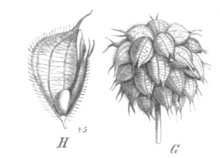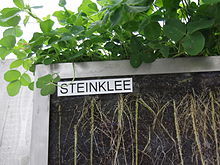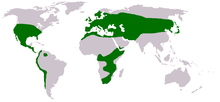Clover
![]()
The title of this article is ambiguous. For other meanings, see Clover (disambiguation).
Clover (Trifolium) is a 245 species genus of plants. It belongs to the subfamily of the papilionaceous plants (Faboideae) of the legume family (Fabaceae). In common usage, however, not only species of this genus are referred to as "clover", but also species from the closely related genera Medicago and Melilotus, as well as from the taxonomically distant genus Oxalis. Characteristic features of the genus are three-lobed leaves and many-flowered, capitate inflorescences. The genus Clover is naturally distributed on all continents except Australia and Antarctica. In Australia, several species of clover have been introduced by humans.
In agriculture, 16 different species of clover are used as forage plants. Clover cultivation is of economic importance in both Europe and North America. In Europe, meadow clover (Trifolium pratense) has been cultivated since the 4th century. Due to its ability to fix nitrogen from the air at the roots in symbiosis with nodule bacteria (Rhizobiaceae), clover is also significant for improving soil fertility.
The shamrock found its way into the symbolism of many cultures. It always represents the trinity, as for example in Christianity as a symbol of the Trinity. Furthermore, clover stands for summer or symbolizes love. The four-leaf clover is considered a lucky charm. In addition, the shamrock is a sign for Ireland.
Description
Most clovers are perennial, but a few are annual (annuelle) and very few are biennial (bienne) herbaceous plants. Almost all species branch directly at the base or along the entire shoot axis. However, a few species develop a long, leafless, unbranched stem above a dense tuft of many leaves directly at the base. The shoot axis may be erect, decumbent, or creeping. Many clovers, such as Caucasian clover (Trifolium ambiguum), produce rhizomes. If rhizomes are present, they often constitute a significant portion of the dry mass of the plants; in the case of Caucasian clover, this is about 44% of the total mass. Less common is the development of stolons. It is found, for example, in white clover (Trifolium repens). The density of the pubescence of the plants varies from species to species. The spectrum ranges from densely hairy to almost glabrous or completely hairless. The orientation of the hairs can be abutting or protruding. They are directed upwards or downwards.
Roots
The root system of the clovers is often herringbone-shaped. The shape varies only slightly depending on the substrate, only the number of branches seems to be higher in sandy soils than in clay soils. Annual species have fine fibrous roots, perennial species have thickened, woody roots and rarely even tubers.
Root swellings (nodules) caused by nodule bacteria are typical of all legume species. The different clovers root to different depths. Trifolium purpureum, for example, roots up to 2.1 meters deep, whereas roots of shield clover (Trifolium clypeatum) rarely penetrate deeper than 40 centimeters into the substrate. In ten species studied, the share of roots in the dry mass of the plants was between 14 % and 30 %.
Leaves
The stem leaves are usually alternate. In some species the upper stem leaves appear opposite; here the upper nodes are so close together that a false impression of opposite is given. In this case, however, one of the two leaves is often not fully developed. The leaf blades are trifoliolate in almost all species. Only species of the subsection Lupinaster in the section Lotoidea have five- to nine-pinnate leaves.
The lower (basal) leaves often differ strikingly in size and shape from the upper leaves. The pinnae here are often ovate, obovate or broadly elliptic, always significantly wider than the pinnae of the upper leaves. The pinnate shape is a relatively stable feature. However, it may vary to a small extent both on an individual and within a species. The leaf margin is entire or finely to coarsely toothed. The blade is hairy on both sides or only on the underside of the leaf, but in some species it is glabrous. The leaf veining is uniform within the species. The secondary leaf veins branching from the main vein run nearly parallel. They or their branches reach the leaf margin.
The shape of the stipules is also strongly conserved (uniform) within certain groups. The spectrum ranges from narrow and abruptly acuminate in the upper half to broadly elliptic. They are entire in all sections except Involucrarium and Paramesus, in these they are toothed, or deeply incised with lanceolate lobes. In the species of the African subsection Ochreata the petioles of the stem leaves are fused to the stipules for the whole length, and the internodes are thus sheathed. However, similar fusions, but only on the petioles of the upper stem leaves and not so pronounced, also exist in other species.
Inflorescences
The inflorescences are usually axillary and stalked or very rarely stalkless. In a few species, however, they are also terminal. Mostly they are capitate and many-flowered. Inflorescences with few single flowers are the exception.
In 1972, the Israeli botanist Michael Zohary studied the inflorescence forms in the section Lotoidea. There it was found that almost all species form panicle-like inflorescences, but there is a tendency towards spike-like inflorescences. Evolutionarily more advanced species also appear to form shorter inflorescences. However, it is unclear whether these results are representative for the whole genus.
Bracts are found mainly in the more primitive sections of the genus, always together with panicle-like inflorescences. Overall, two different evolutionary trends are recognizable in the genus: on the one hand, the regression to bracteole rudiments or the complete disappearance of bracts, and on the other hand, the aggregation of bracts directly below the head, leading to involucral formation (bracts). Distinct bracts are present, for example, in the section Mistyllus, which is one of the evolutionarily primitive sections of the genus. Rudimentary or absent bracts are found for example in the section Trifolium, bracts are found for example in the section Involucrarium.
Blossoms
The calyx in the genus Clover is mostly symmetrical and tubular or bell-shaped with five nearly equal calyx lobes or teeth. Three variations of the calyx are common: In species of the subsections Loxospermum, Calycospatha, and the section Mistyllus, the calyx tube is vesicularly thickened. In some other species, especially in the section Chronosemium, the upper two calyx teeth are shortened compared to the lower three. Finally, in section Trifolium, closed calyx tubes are often found.
Clover flowers are five-petalled butterfly flowers. The crown varies in colour from pure white to yellow to dark purple. Two-coloured crowns are common. Often the color changes after anthesis (process of flowering) and the inflorescences appear multicolored. The four lower petals (aisles and wings) are loosely fused and attached to the stamens. The fifth petal (the plume) is free and enlarged. The wings are usually much longer than the shuttle. The stamens are ten in number, nine of them fused into a U-shaped tube. At the base of the tenth, upper, free stamen is a small honey-gland (nectary). In some species there is a tendency to reduce the number of pollen sacs per stamen, as in Trifolium badium, T. repens, T. campestre, and T. dubium; stamens with the normal four, but also three and two pollen sacs occur in a flower, the ventral pollen sacs being reduced in each case. The ovary lies within the tube of stamens. The corolla usually falls off early and is retained only in some species. In section Mistyllus the remaining corolla dries up. Only in the section Chronosemium it has a supporting effect on the blowing away of the seeds (wind pollination).
Pollen
The pollen grains of the genus are prolate, which means they have the shape of rotational ellipsoids. The exine, i.e. the outer layer of the sporoderm (the wall of the pollen grain), is tricolporate, i.e. it has three elongated germinal folds (colpi), in the middle of each of which there is a roundish germinal pore (porus). The pollen grains have a diameter of 14 to 35 micrometers. They are 21 to 49 micrometers long and have a length to diameter ratio between 1.19 and 1.64.
The smallest pollen grains are found in small-flowered clover (Trifolium retusum) and slender clover (Trifolium suffocatum). The largest pollen grains were observed in meadow clover (Trifolium pratense). In some American species, such as Trifolium albopurpureum, the pollen grains are almost spherical. The surface structure (sculpturing) of the pollen grains varies greatly within the genus.
Fruits
The original fruit form of the genus is considered to be many-seeded legumes, tearing open at two seams. Within the genus, there are both this archaic fruit type and many evolutionarily derived forms that increasingly approximate the closing fruit. In the section Lotoidea, in which most of the evolutionarily primitive characteristics of the genus are preserved, quite a number of species, such as bird's-foot trefoil (Trifolium ornithopodioides) or western alpine trefoil (Trifolium alpinum), are found with such typical many-seeded pods that burst open at two seams. From this initial form many derived forms exist: in the extreme case a one-seeded tube (utriculus) or a nutlet with a very thin pericarp, which in some cases even consists only of epidermal cells (terminal tissue). In these extremely reduced pods the suture is absent, and so the fruit cannot split open, but divides transversely or irregularly. Such fruits are mainly found in the section Trifolium, for example in the spreading clover (Trifolium diffusum), but also in many other sections and even in Lotoidea.
An intermediate form is the one-seeded pod, in which both sutures are present. Fruits of this form can be found for example in the Usambara clover (Trifolium usambarense), in Trifolium burchellianum but also in many other species. Another intermediate form is the one-seeded pod with only one suture. This fruit type is found in several sections, but is rather rare.
Seeds
The shape of the seeds is typically ovoid, ellipsoid or elongated-ellipsoid and laterally compressed, but varies in dimension, weight and shape. Variations in shape result from the different position of the hilum, the attachment point of the umbilical cord (funiculus) by which the seed is connected to the ovary. The hilum separates the root system (radicle) from the cotyledons in the embryo.
In some species, for example in the three subsections Lotoidea, Oxalioidea and Ochreata in the section Lotoidea, the hilum is terminal. Here the root system and the cotyledons are almost of the same length. In almost all other species the hilum is situated laterally or at the margin. Then the root system is clearly shorter than the cotyledons. The seed coat (testa) may be smooth, roughened, warty, wrinkled or granular. However, the surface structure of the testa does not seem to correlate with the taxonomic classification of the genus.
Cell Biology
About 70% of the species in the genus have been studied for the number of chromosomes. Species are usually diploid, containing two sets of chromosomes per cell. However, other degrees of ploidy also occur. Polyploidy, or polyploidy and diploidy in two lineages side by side, occurs in 38 species. Of these, 31 are perennial species, but only seven are annuals.
The base number, that is, the number of chromosomes in a single set, is 8 for 80% of the species studied, 7 for 15% of the species, 6 in 2% and 5 in 3% of the cases. The base number 8 also seems to dominate in the other species of Tribus Trifolieae. Reduced chromosome numbers and aneuploidy, meaning that single chromosomes are present or absent in addition to the usual set of chromosomes, are most common in the sections Trichocephalum and Trifolium. This is further evidence that these sections are more derived forms than the others.
The shape of the chromosomes was studied in 14 African and 15 European diploid species. There were one to three pairs of metacentric (centromere in the middle), four to six pairs of submetacentric (centromere between middle and end) and one pair of acrocentric chromosomes (centromere at the end, the shorter arm very small).

Seeds of Swedish clover (Trifolium hybridum)

Illustration of the fruits of strawberry clover (Trifolium fragiferum) - one to two-seeded pods, which tear open at two seams.

Spike-like inflorescence of narrow-leaved clover (Trifolium angustifolium)

Typical clover leaf (here from white clover (Trifolium repens)) - The almost parallel lateral veins branching off from the main rib are clearly visible.

Roots of red clover and sweet clover in close-up (this is a section of the roots, you can't see the full length). Note the label on the photo is not correct, there is not only sweet clover but also red clover in the box; probably due to wild growth.
Distribution
The genus Clover is very widespread and is represented in a total of four floral kingdoms, Neotropis, Palaeotropis, Holarctic and Capensis. However, the genus is absent from Australis. The range can be divided into three distinct centers: Eurasia, Africa, and the Americas.
About 59% of all species are native to Eurasia. The centre of diversity, i.e. the area with the highest species diversity (a total of 110 species from seven sections), is in the Mediterranean region. In contrast, the Euro-Siberian and Turanian-Iranian regions together contain only 8% of the species. Almost every Mediterranean country has some endemic species. However, most endemics are found in Turkey, with a total of nine endemic species out of the 100 naturally occurring there. The northern limit of the range runs through Sweden and Norway, where it reaches about the Arctic Circle. Towards the east, the natural species diversity decreases and only the two species Trifolium lupinaster and Trifolium gordejevi are found in the Far East of Russia, on Sakhalin and in Japan.
In Africa, 15 % of all species are distributed. The majority of the species occurring in North Africa are native to the Mediterranean region, as in Europe. Here, however, only two endemic species exist, both in the Atlas Mountains. Half of all North African species are also found on the Macaronesian islands. Almost all species not found in Europe are found in the highlands of Abyssinia. Clover is absent from the Arabian Peninsula, with the exception of the Yemeni highlands. The range continues to the Cape in the far south of Africa, but here clover is found only in the tropical highlands and is absent in the lowlands. Clover is absent from Madagascar, Namibia, Botswana and the Sahel. The only species that reaches the northern edge of the Sahara is the felt clover (Trifolium tomentosum).
The remaining 26% of the species are distributed in the Americas. In North America, clover is absent from Alaska and most of Canada, and in the United States it is absent from the Northeast. The center of diversity is in California. To the south, the range extends to about 43° south latitude in South America. In this, even in the tropics of the Americas, clover is found only in the highlands and is absent in the lowlands. Clover is absent from the West Indies, Panama and Guyana.
The native species are joined by many neophytes, especially in North America. Of the ten species described in 1739 by Jan Frederik Gronovius in the Flora Virginica, nine turned out to be introduced. In 1994, 93 clover species were known from the United States, of which 64 occur naturally there and 29 are neophytes.
Even in Australia, where clover does not occur naturally, many species are neophytic. Thus, 35 neophytic clover species are counted in south-western Australia. However, introduced clover is also found in the alpine regions of eastern Australia. A total of ten species are classified as invasive. Clover has also been introduced to New Zealand and Hawaii.

Distribution map of the genus
Search within the encyclopedia